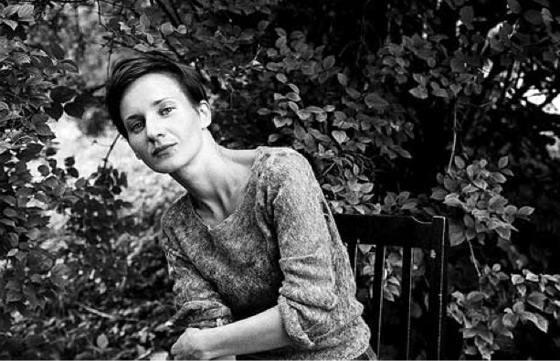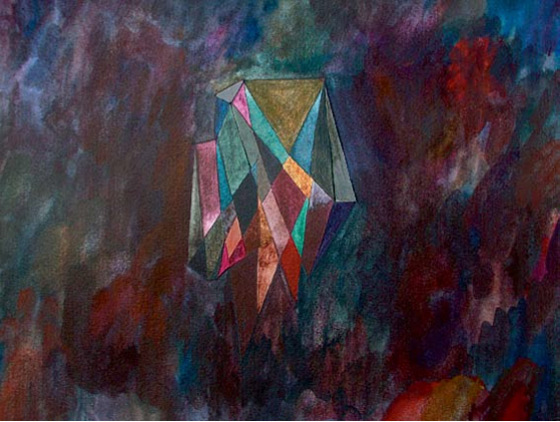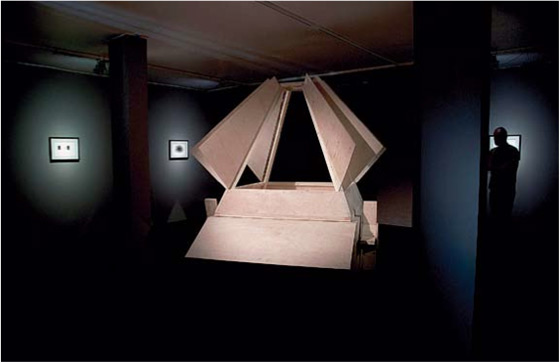|
|
| Divided Time Loop Katrīna Teivāne-Korpa, Culture Theorist Evelīna Deičmane. Burt Nieks(1) 15.09.–29.09.2012. Burtnieki Culture Centre Evelīna Deičmane. Division of Time 05.10.–18.11.2012. kim? Centre of Contemporary Art | |
 Evelīna Deičmane. 2012 Photo: Mārtiņš Grauds Courtesy of the artist | |
| Given that this issue of Studija reaches the reader in February, talk ing about the end of the world is no longer topical. Nevertheless at this point in time I still have two more weeks to go before the muchheralded 21 December, hence it seems kind of important for me to mention that date. I will unashamedly admit that this [last] year’s apocalyptic currents in the air, tensions haunting me since childhood (the spectre of nuclear war looming in the 1980s and the gloomy vistas of 2000) and the nonstop harping on the topic in the public space, to say nothing of predictions by prophesiers of various levels of credibility, had their impact both on the mood and the experiencing of exhibitions, especially in the autumn. Leaving aside impressions of the events widely discussed in the press – a solo exhibition by Arturs Virtmanis (10 000) melanholijas šķautnes ((‘10 000) Melancholy Folds’) and a solo exhibition by Miķelis Fišers Lielviela (‘Megamatter’), I am going to focus on two expositions of Evelīna Deičmane's works: Burt Nieks (1) at the Burtnieki Culture Centre (15–29 September) and Laika dalīšana ('Division of Time') at the kim? Centre of Contemporary Art (5 October – 18 November). Burtnieki is a special place and owes its special aura to Lake Burtnieks, featured in a vast lore of tales, legends and beliefs. One part of the stories tells that there is a sunken church in the lake, while another – that the deep hides the Burtnieki Castle together with all the wisdom of our people. The second version has been instrumental in creating the sym bolism of the national awakening: the motif of the castle and its im minent emergence from the dark depths of the lake as the waken ing of the people’s spiritual power pervades Auseklis’ epic poem Gaismas pils (‘The Castle of Light’), and has a significant role both in Andrejs Pumpurs’ epic Lāčplēsis (‘The Bearslayer’) and the play by Rainis Uguns un nakts (‘Fire and Night’). And it was at Burtnieki that in 1988, during the Latvian Third Awakening and 100 years af ter Pumpurs first published his work, that the openair stage in the manor park was the venue for a first performance of the rock opera Lāčplēsis, a momentous event of in terms of the nation’s emotions. Today the significance of Burtnieki is further added to by the fact that artist Evelīna Deičmane comes from here, but, for example, the famous Burtnieki horses as an embodiment of wildly elemen tal beauty have been depicted in a number of works by the notable Latvian photographer and longstanding chairman of Riga Photo Club, Imants Puriņš. Besides, Burtnieki is also home to the old masster's archive. The trip to the exhibition at Burtnieki was partly furthered by last year’s theme of the Survival Kit art festival – downshifting. Whilst failing to induce any particular desire to get immersed in the issues of slowing down the pace of one’s lifestyle (here with us things go quite slowly anyway), the theme was instead an encouragement not to see the lack of a car as an obstacle and, bright and early on a work day morning, to go on an excursion into the countryside by bus. First to Valmiera, and from there – on to Burtnieki. The bus driv er said that we would recognize the place at once. And that is how it was: everything very tidy, beautiful, autumnally colourful and with out a living soul around – the landscape as seen through the window immediately attracted attention. The bus stop is right by the new Culture Centre. As all the denizens of Burtnieki had already seen the exhibition, and nobody else was likely to hurry to this distant village for art, it was under lock and key. Nevertheless, we had been smart enough to book the visit in advance, and so the centre doors were kindly opened without delay. Evelīna Deičmane wrote in her exhibition preamble: “They are memories of my school days and farm work. I remember that it seemed as if there were strange goings on happening in the village. Local kids and teenagers shared what they’d heard and seen. At the same time, it seemed that there were many things that the adults were trying to hide from us. Everything is there, dread alternating with laughter. In my memories Burtnieki was like the calm before the storm." Personal observations on Burtnieki residents and the feeling of silent threats (the flow of time) were enhanced by a legend about Lake Burtnieks intertwined in the exhibition. This is about the lake’s origins – a flying black cloud which is to be called by its rightful name so that it will not scare the villagers and fall down in its right place.(2) And so what opened up for viewing was the wondrous life of the Burtnieki people in sketches of fairytale memories, accompanied by the sounds of water created by a balancing wooden triangle. | |
 Evelīna Deičmane. Opinion and its dissolving. Watercolor on paper. 2012 Publicity photos. Courtesy of the artist | |
| The display started in the Culture Centre foyer, where there were two works on show: a year 2009 video and sound installation Pārejošas bēdas (‘Season Sorrow’), which the artist presented at the 53rd Venice Biennale, and a photograph from 2012, Viss tas tikai manā galvā (‘All That is Just in My Head’) of the Nemiers (‘Unrest’) series. Both works were a kind of supplement to the main exposition in the Culture Centre’s small hall. The Burt Nieks exhibition features 14 drawings: three larger abstract works and eleven finely elaborated, neatly framed sketch like pictures that could also be perceived as illustrations for the titles pinned on the wall in one corner of the room. Expressed as brief po ems, in a single sentence or just a few words, they were like minia ture stories. On the whole, the unison of drawings and texts could be called the “magic realism” of Burtnieki, where the mundane and the imaginary exist side by side, completely free and at ease, and in their own special manner. An unfulfilled, or more precisely, a “where are they?” feeling was only left by the fact that on the sheet of pa per there were the stories of 37 drawings... The artist explained that one of the reasons why a complete selection of works had not been exhibited was because there was some doubt about a rural viewer unprepared for contemporary art, who might be unhappy with a lineup of smallscale, unframed drawings that could not really be put on the wall. All the worry, however, had proved to be unfounded: whenever something had seemed confusing or wrong, the Burtnieki locals would immediately come to the artist to get things straight. Just like the drawings, the centrepiece of the exhibition also, a kinetic sound installation in this exposition titled Division of Time, had been created during a residency at Künstlerhaus Bethanien Ber lin in 2011. An equilateral wooden triangle balancing on a log has been placed in the middle of the room. Inside the object there are buckets of water, each bucket containing a water pump. As this is operating, enough water is pumped for the triangle to tilt and cre ate the sound of waves. In a short while, the other pump unobtru sively starts working and makes the opposite corner of the object tip over. It’s like the story about Lake Burtnieks in the triangle of time – once upon a time the lake had been flying, now it has fallen down, and one day the church with its castle of wisdom will rise up out of it. The swinging of the triangle also creates a feeling that, with each wave, the room itself is tilting, together with all the drawings. By co incidence, the lake theme and the narration of the legend were also enhanced by the Culture Centre ceiling, which loomed from above like the frostbound edges of the lake, mirroring the whole exposition. This series of works includes yet another sound installation which unlike the drawings could not be exhibited here due to its large size. A rectangular object laid on the floor is an extraordinary string instrument, of which each string is played by a ventilator mo tor. The object’s structure is said to create a lowpitched booming sound, as if coming from under water. The exhibition stayed with us in some kind of way even when we had already left it in order to go on a small sightseeing tour. That day Burtnieki in its entirety served as an architectural framework for the exposition, and also as confirmation that all those things are not just the fruits of Evelīna’s imagination. A snag overgrown with moss and other gifts of nature protruded like a goat’s foot from the (as the story goes, once tiled) pool in the lord of the manor’s park. Every now and again we came across weirdlooking stones. As if deliber ately but still of their own accord, various objects had neatly lined up along the way; it seemed that each had a story to tell – just let them speak. Undulating serenely in its proper place was the famous lake, now with a newly built, EUfunded boat pier with lanterns. The lovely park tightly embraced the only visitors by its scenic splendour, creat ing an inexpressible feeling of joy, and the Burtnieki people that we met took care, with an occasional sly glint in the eye, to keep this feel ing alive until the evening bus arrived to take us back to the capital. Since 2008, Evelīna Deičmane herself has regarded and created her works as logical sequels. One time segment leads to the next. Thus Nje Mechtaj I Nje Dumaj (in Russian – ‘Don’t Dream and Don’t Think’) brought the artist closer to her grandparents’ experiences, ‘Season Sorrow’ – to her parents, while Burt Nieks was a return to her own childhood. As to the exhibition ‘Division of Time’ at kim?, Evelīna noted that she now enjoyed dealing with the present, because in this way there is an opportunity to catch a glimpse of and look into the future. Thereby the works are not created to carry a certain mes sage, but as a form for things just experienced. For the sake of clarity I will add that, although the exhibiton accompanying texts state that all the works were created during the Bethanien residency, there is only one like that. On the others Evelīna worked at Burtnieki in the summer of 2012. The room where ‘Division of Time’ was displayed was immersed in a dusky twilight, depriving the hall of its contours. The only light ing that there was fell on the watercolours of multifaceted and circleshaped figures on the walls, and the sound object in the middle of the room(3) – a wooden chest in the shape of a prism. This had taken over the baton from the Burtnieki triangle and, just like the exposition itself, adopted the title Division of Time. | |
 Evelīna Deičmane. View from the exhibition Division of Time. 2012 Photo: Edgars Jurjāns. Publicity photo Courtesy of the artist | |
| As far as I know, the work has another title also, Viena cilvēka māja (‘One Person’s House’), which explains the idea behind it more com prehensibly. The prism is reminiscent of a human (the artist’s) figure. Its sides can be opened, for a human being is not a closed form. The watercolours placed around the sound object depict some moments captured in the endless process of formation, or the very stages of transition themselves. They offer an interpretation on the tempestu ous relations between the human and time – not along a progressive curve, but as an incessant colourful process of crystallisation. This, of course, opens up opportunities to engage in colour, religious and mythological symbolism. Whichever is for each is closer, when con templating an individual’s spiritual life. Interestingly, geometrical and multifaceted crystalline forms also featured extensively in the exhibition works by Artūrs Virtmanis and Miķelis Fišers. When thinking of the “wise rocks” of Fišers’ cos mic landscapes, one is tempted to draw visual parallels with the geo metrical shapes in Deičmane’s works. But just for a moment. In the Megamatter works they were dwellers of worlds existing beyond our time and knowledge, composed and independent in their complete ness, while in ‘Division of Time’ it was an image of the state of the soul captured at a certain moment of a person’s life: finely wrought and once more in anticipation of change. Returning to ‘Division of Time’, one particular work has increas ingly attracted me over the months, this being Bezgalība. Tā pārlūza (‘Infinity. It broke’). The figure depicted in the watercolour (though overall one is inclined to call them drawings) looks like a tipped over hourglass. The rounded lines of the figure of eight have been smoothed down this time, and the tips of both yellow triangles are covered by black rectangles, keeping in balance both loops of infinity so that their fine connection would not be broken. I see this as an apt depiction for the experience of the revelation of one’s personal tem porality, when the apparent infinity of time ever expanding before you is disrupted and all the sand from the hourglass runs together into the one present moment. In her work, however, Deičmane has thought more about seeking and maintaining balance between the human, at one end of th infinity loop, and the Universe at the other. The wooden triangle at the back of the exposition space, already known from the Burtnieki exhibition, also aspired to convey this tension in relations – here the work bore the title Galva. Slikti. Labi (‘Head. Bad. Good’) or Labi. Slikti. Labi (‘Good. Bad. Good’). This does not matter much, because most probably in some future exhibition the object will acquire a new interpretation and will be given a to tally different title. That will definitely be the case with the main ex hibit – the “boat”, which never made its intended voyage on the water from kim? to the artist’s workshop on Andrejsala. One work inspires the next and is gradually transformed into it. Divided time connects into an unforseeably long chain... Translation into English: Sarmīte Lietuviete 1 “The word in the exhibition title is split into two parts that have their own meanings. ‘Burt’ here means to bewitch or to enchant and ‘nieks’ here means easy, effortless.” 2 The phrase “Man burt nieks” – ‘To bewitch is easy for me’ appears in a number of legends as the fatal incantation that has made the lake come down to earth in its present location. 3 Sound: Error or Aldis Ozols (experimental, noise, industrial). | |
| go back | |







